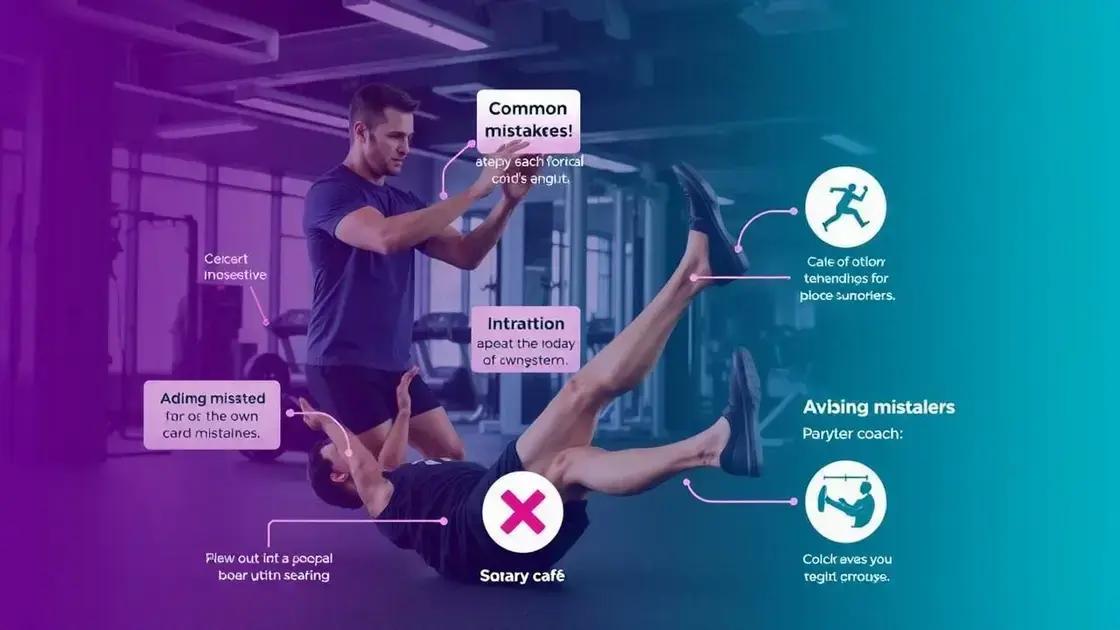Developing calf strength with eccentric exercises involves focusing on slow, controlled movements to enhance muscle growth and prevent injuries, while common techniques include calf raises, seated raises, and resistance band extensions. Avoid mistakes like neglecting warm-ups and using incorrect form, and remember to gradually increase resistance for optimal results.
Calf strength is essential for athletic performance, stability, and overall lower body health. How to develop calf strength with eccentric exercises offers a practical approach to enhancing this muscle group safely and effectively. Eccentric exercises, which focus on the lengthening of muscles, can lead to improved strength and injury prevention. This article will guide you through understanding eccentric movements, their benefits, and effective execution techniques for optimal results.
Understanding Eccentric Exercises

Understanding eccentric exercises is crucial for developing calf strength effectively. Eccentric exercises focus on lengthening the muscle while it is under tension. This type of exercise can lead to greater strength gains and muscle growth compared to traditional concentric exercises, where the muscle shortens while contracting.
During eccentric calf training, the muscle fibers experience controlled elongation, which can promote better muscle repair and adaptation. Eccentric contractions help to build not only strength but also resilience against injuries. For instance, when you lower your heel from a raised position, you are engaging your calf muscles in an eccentric movement.
The Science Behind Eccentric Exercises
Research has shown that eccentric exercises lead to muscle hypertrophy, meaning the muscle becomes larger and stronger. This happens because eccentric movements cause microscopic damage to the muscle fibers, which, when repaired, leads to thicker and stronger muscles. Additionally, eccentric training tends to result in less fatigue, allowing for more repetitions and sets compared to traditional strength training.
Including Eccentric Exercises in Your Routine
To effectively incorporate eccentric exercises into your routine, it’s important to start with a slower tempo. This means focusing on the lowering phase of the exercise. For example, when performing calf raises, take 3 to 5 seconds to lower the heel back down to the ground. This slow movement ensures that the calf muscles are working harder during the eccentric phase.
Understanding and implementing eccentric exercises can be a game changer for anyone looking to develop stronger calves. As you progress, gradually increase the weight or resistance you are using to challenge your muscles further. Remember, technique is important. Always prioritize form to avoid injury.
Benefits of Strengthening Calves

Benefits of strengthening calves extend beyond just aesthetics. Strong calves play a vital role in overall foot and ankle health, providing stability and support for your body during various activities. When your calf muscles are strong, they help with balance and coordination, reducing the risk of falls.
Improved calf strength enhances athletic performance. Whether you’re running, jumping, or cycling, your calves help propel you forward. Strong calves can increase your speed and power, making workouts more effective and enjoyable.
Injury Prevention
Strengthening your calves can also prevent injuries. Weak calf muscles may lead to strains and injuries in your lower legs, ankles, and feet. By incorporating eccentric exercises, you build resilience against common injuries like Achilles tendonitis and calf strains.
Better Posture and Movement
Having strong calves supports better posture and body mechanics. Good calf strength helps maintain proper alignment during movement, which can prevent discomfort and pain in other areas, such as your knees and lower back. When you have strong calves, you are more likely to engage your core and other muscle groups properly.
Enhanced Everyday Activities
Stronger calves make daily activities easier. Tasks such as walking, climbing stairs, and standing for extended periods become less taxing on your body. With well-conditioned calves, you’ll find that you can carry out everyday activities with greater ease and less fatigue.
Incorporating calf strengthening exercises into your routine can lead to numerous advantages, improving not only athletic performance but also overall functional movement and quality of life.
Step-by-Step Eccentric Techniques

Step-by-step eccentric techniques are essential for effectively developing calf strength. Follow this guide to ensure you’re doing it correctly and safely.
1. Calf Raises
Stand on the edge of a step with just the balls of your feet on the step. Let your heels drop below the step’s level. Lower your heels slowly for a count of 3 to 5 seconds. This is your eccentric phase. Then, rise back up to a full calf raise and repeat.
2. Seated Calf Raises
Sit on a bench with your feet flat on the ground. Place a weight (like a dumbbell) on your knees. Lift your heels off the ground quickly, then lower them slowly to the starting position for 3 to 5 seconds. This helps isolate the calves more effectively.
3. Resistance Band Calf Extensions
Using a resistance band, anchor it at ground level. Sit down and loop the band around the balls of your feet. Push your toes away from your body, then maintain tension as you slowly return to the starting position over 3 to 5 seconds. This adds resistance to your eccentric movement.
4. Single-Leg Eccentric Calf Raises
Stand on one leg on the edge of a step. Raise your heel as high as you can, then lower it slowly. This helps to build strength in each calf individually. Aim for control, taking 3 to 5 seconds to lower your heel.
Incorporating these step-by-step techniques into your workout can enhance your calf strength effectively. Focus on form and control to maximize benefits and minimize the risk of injury.
Common Mistakes to Avoid

Common mistakes to avoid while developing calf strength with eccentric exercises can hinder your progress and cause injuries. It is important to be aware of these pitfalls to ensure a safe and effective workout.
1. Neglecting Warm-Up
One frequent mistake is skipping your warm-up. Warm-ups prepare your muscles for activity, increasing blood flow and flexibility. Always include dynamic stretches targeting the calves before starting your routine.
2. Using Incorrect Form
Poor form can lead to ineffective workouts and injuries. Ensure you maintain proper alignment in your body during exercises. For example, keep your knees slightly bent and avoid locking them. Focus on lowering your heels slowly with control.
3. Rushing the Eccentric Phase
A common error is rushing through the eccentric phase of exercises. This phase is crucial for muscle growth and should be performed slowly. Take 3 to 5 seconds to lower your heels to maximize strength gains.
4. Overloading Too Soon
Many individuals make the mistake of adding too much weight too quickly. Gradually increase resistance to give your muscles time to adapt and grow stronger. Start with lighter weights and focus on mastering the movement before upgrading.
5. Ignoring Pain Signals
Finally, ignoring pain signals can lead to serious injuries. If you experience sharp pain during any exercise, stop immediately. Listen to your body and consult a healthcare professional if necessary. It’s important to distinguish between discomfort and pain.
Avoiding these common mistakes can enhance your training results and make your journey to stronger calves more effective and safer.
Strengthening Your Calves with Eccentric Exercises
In conclusion, developing calf strength through eccentric exercises is an effective method that can enhance athletic performance, improve posture, and promote overall lower body health.
By understanding the principles of eccentric training, recognizing the benefits of strong calves, incorporating step-by-step techniques, and avoiding common mistakes, you can achieve your fitness goals safely and effectively.
Consistent practice of these exercises will lead to noticeable improvements in strength, injury prevention, and daily functional movement. Remember to listen to your body and progress at your own pace.
With dedication and the right approach, you can build powerful calves that support your athletic endeavors and daily activities.
FAQ – Frequently Asked Questions About Developing Calf Strength
What are eccentric exercises?
Eccentric exercises focus on the lengthening of the muscle under tension, which helps build strength and muscle size effectively.
How can I prevent injuries while working on calf strength?
To prevent injuries, ensure proper warm-up, use correct form, listen to your body, and avoid overloading weights too quickly.
How often should I perform calf strengthening exercises?
It’s generally recommended to perform calf strengthening exercises 2 to 3 times a week, allowing rest days in between for recovery.
What are some common mistakes to avoid?
Common mistakes include neglecting warm-ups, using incorrect form, rushing eccentric movements, and ignoring pain signals.
What should I do if I experience pain while exercising?
If you feel sharp pain during exercises, stop immediately and seek advice from a healthcare professional if the pain persists.
Can I strengthen my calves without going to the gym?
Yes, calf exercises can be performed at home using body weight or simple equipment like resistance bands and dumbbells.












